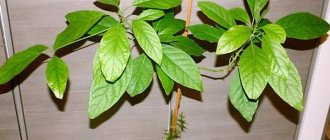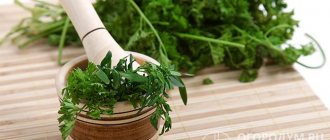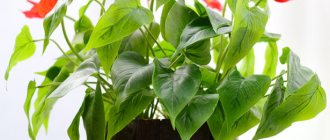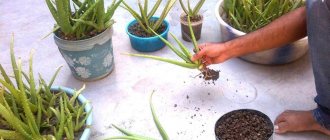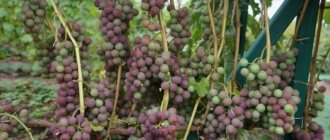2.What does an avocado look like?
The genus name "Avocado" comes from the Aztec word meaning testicle for the shape of the fruit. It is a multi-stemmed tropical evergreen small fruit tree or shrub. Branches abundantly, forms a crown.
The leaves are simple elliptical, up to ovate, leathery, usually glossy with pointed tips 10 - 20 cm long and 2 - 12 cm wide, dark green in color, arranged in a spiral, alternate, may be slightly corrugated.
↑ Up,
Photo: Krzysztof Zarnek, Kenrise
How an avocado blossoms. The flowers are inconspicuous, small, collected in short bunches - umbrellas at the ends of the branches, greenish-yellow in color
The avocado fruit, when ripe, is a pear- or ovoid-shaped drupe with one seed surrounded by an oily pulp, topped with a tough, dark green skin. The size of the fruit varies depending on the variety, approximately 5 - 10 cm long and 0.05 - 2 kg. The taste of ripe fruits is light creamy, slightly oily and slightly sweet.
Height. Avocado grown at home reaches a height of 1 - 2 m; in greenhouses and winter gardens its height is 3 - 5 m, in natural conditions it is about 18 m, it grows quickly.
↑ Up,
Photo: Eran Finkle
Trimming and pinching an avocado
In nature, the tree grows up to 20-25 meters. Indoor wood is always limited to ceilings and walls. To ensure that it does not interfere and maintains a beautiful, neat shape, the avocado must be trimmed and young shoots pinched. Pruning is also necessary to remove old, deformed and damaged branches.
Trimming
It is optimal to start pruning from 4 years after planting. By this time, the tree has already taken its shape, and it becomes necessary to maintain it. Pruning is best done before the dormant period. When preparing a plant for wintering, unnecessary branches and shoots are removed. Repeated pruning is carried out in early March. The cuts must be made with a sterile instrument, and the damaged areas must be lubricated with special preparations, such as garden varnish.
Important! In order for the plant to bear fruit, for the first 5-7 years you need to pinch the emerging buds without waiting for them to bloom.
In order for avocados at home to produce more lateral branches, young shoots stretching upward must be pinched several times. The first pinching should be done when the tree reaches 250 mm in height. The top two pairs of leaves are pruned. After this, pinch out when the side branches reach 120 mm. The 3rd and 4th pinching also occurs.
3.How to grow an avocado from a seed on a windowsill
Houseplants are often grown from seeds, which can be sprouted in water or directly in soil. It is better to propagate in spring. Fresh seeds have the highest percentage of survival - only from a ripe fruit - but how to determine it? The fruit should sag slightly to the touch and immediately restore its shape. Unripe avocados can be wrapped in thin paper and sent to a dark place for 1-2 weeks to ripen. It’s a good idea to place a ripe apple or banana nearby - they emit acetylene gas, which speeds up the ripening of the avocado. In ripe ones, even slightly dried avocado seeds have difficulty germinating. For germination to be successful, you need to wash the seeds to remove the pulp. Sometimes the fruit pulp adheres too tightly to the seed and in order to separate it, it is worth soaking the seed in water for several hours. It is also worth peeling off the brown shell from the stone so that the halves of the stone will become visible. First, you can lightly cut the seed from the sides with a sharp knife along the halves of the seed - later it will split along this line.
When germinating in soil, the seeds are deepened with the blunt end down so that they stick out by a third from the substrate, which must be kept constantly moist.
When germinating in water, the seeds are placed with the wide end down 1/3 of the height into water or moist soil. If a seed sprouts in water, to give it stability, you can strengthen it with toothpicks, which will rest on the edge of a glass or jar of water. Activated carbon can be added to the germination water. The bone placed in this way should be covered on top with glass or a transparent plastic cap to maintain humidity. Without such shelter, the seed can only split from the bottom and the sprout will have nowhere to develop. The water is changed regularly - approximately every week. At a temperature of about 20 ° C, after 6 - 8 weeks the seeds will split and roots will appear, and then a sprout.
So, germinating an avocado is not difficult at all. Once the sprout and roots appear, the seed is planted in the ground so that the top of the seed protrudes slightly from the soil. Crops also need to be covered with a plastic cap or even a simple plastic bag to maintain the required level of air humidity. Every day, remove the bag and ventilate the plant for about 2 hours.
The third way to germinate seeds is to germinate them in a paper towel or gauze. The gauze is soaked in warm water and an avocado pit is placed inside. Place the bundle in a plate and cover it with a plastic bag to maintain moisture, place it in a dark and warm place. Do not let the gauze dry out and after 3 - 8 weeks you will see the first roots, when they reach 7 cm in length. The plant can be planted in the ground. For faster germination, you can cut off the thin caps from the flat and sharp ends of the seed with a sharp knife. Young plants are pinched for the first time when 4-6 leaves appear - this way they form a larger number of side shoots.
Sometimes they try to use vegetative propagation or cuttings of avocados using semi-lignified stem cuttings - but it is rarely successful; the bush is difficult to grow even with the use of growth hormones. If you want to try, cover the cuttings with a clear bag or glass and place them in a warm place out of direct sunlight.
↑ Up,
Photo: B.navez
Plant care
It is not difficult to germinate an avocado from a seed, but further growth and development will require careful care of the seedling. Otherwise, the tree will simply die. Particular attention should be paid to temperature conditions and timely pruning of the plant.
Required climatic conditions
It is better to choose a permanent place for the avocado in advance, since the tree grows quickly and moving it from place to place will be problematic. Avocado does not really like shade, its growth slows down, and the leaves of the crown become dull. The optimal place is by the window on the west side of the room. Areas with good lighting are more suitable for the tree, but it must be protected from direct sunlight.
In spring, it is recommended to cover the trunk with whitewash or white paint to avoid sunburn. In winter, experts recommend increasing daylight hours with the help of phytolamps.
Like any tropical plant, avocado reacts sharply to changes in temperature. Ideally, the air around the tree should be around +22-26℃. With a sharp drop in temperature, as well as in drafts, leaf shedding may occur. Temperatures below +5℃ are detrimental to avocados. Therefore, it is not recommended to take the tree out onto the balcony, even if the weather is warm outside.
Dry apartment air negatively affects the condition of avocados. The optimal humidity level is 66-65%. Therefore, it is necessary to irrigate the foliage at least 1-2 times daily. To maintain the required level of humidity, you can place the pot with the plant in a deep tray filled with damp moss or expanded clay. During the heating season, an air humidifier is additionally installed next to the tree.
Watering
In spring and summer, avocados need to be watered abundantly and often without allowing the soil to dry out. In autumn and winter, the frequency of watering is reduced to 1 time every 2-3 days. It is also important to avoid waterlogging the soil. To do this, periodically monitor the soil moisture level at a depth of 2-3 cm.
Top dressing
The avocado seed contains a large supply of nutrients. Therefore, young seedlings do not need additional fertilizer. The first feeding is carried out no earlier than 4 months after transplantation to a permanent place.
As a fertilizer, it is better to give preference to liquid complexes with a high content of nitrogen and potassium. You can use ready-made compositions for citrus fruits. A tree aged one year or older is fertilized 4 times a year. The most preferable feeding time is spring and summer; the plant is not fertilized in winter.
Helpful information
Daria Vorontsova
Amateur gardener. He is interested in growing various greens at home.
Ready-made fertilizers contain little zinc. This element must be added additionally as a separate fertilizer.
Replanting and pruning
The first transplant is carried out after the seedling reaches a height of about 15 cm. In the future, the tree is replanted annually, preferably in the spring. Avocados over 4 years old are replanted once every three years. Transplantation is carried out by transferring an earthen clod.
Additional replanting may be necessary if the plant becomes crowded in the pot. This can be determined by the roots sticking out of the ground.
In the first months of growth, the avocado stretches strongly upward and looks like a bare stem with leaves on the top. Regular pruning will be required to increase the number of side shoots. As a rule, it is carried out in the spring in several stages:
- The first formative pruning is carried out after the appearance of the 8th leaf. To do this, cut off the top of the plant at a distance of 15 cm from the surface of the ground, leaving 2-3 buds on the trunk.
- The second stage is to cut off the emerging shoots when 5-6 leaves appear on them. Each new level of escapes. To form a beautiful crown, each new level of shoots is made 5 cm shorter than the previous one.
- From an adult tree, vertical shoots are removed, as well as overgrown branches in the upper third of the tree trunk. The remaining shoots should be less than half the diameter of the trunk.
Helpful information
Daria Vorontsova
Amateur gardener. He is interested in growing various greens at home.
When pruning, the cut areas must be thoroughly disinfected with a weak solution of potassium permanganate or brilliant green. After processing, the sections are covered with garden varnish or whitewash.
The trunk of a young seedling is quite flexible. Thanks to this property, wood can be given an interesting decorative look. The easiest way is to twist the tree trunk around the peg in a spiral as the plant grows. Over time, you will get a tree with an interesting shape. You can plant several seedlings in one pot and weave their trunks into a braid.
It is important to leave natural gaps between the trunks so as not to subsequently end up with a fused monolith. To prevent the form from falling apart, the joints can be secured at first with thin wire or plastic clamps.
4.How to replant a plant
Can be planted in fresh soil and a larger container annually in the spring. The signal for the need for replanting will be the roots that appear in the drainage holes of the pot. Be sure to place a layer of drainage at the bottom of the pot; make sure the pot has large enough drainage holes. Carefully shake off the roots from the old substrate and dry with a paper towel. When planting, the roots should not be bent or pointing upward. Avocados will grow better in unglazed clay pots so that their walls allow moisture and air to pass through to the roots of the plants. Since the plant has a very modest root system, it would be better to plant it in small pots.
↑ Up,
How it grows in nature
The crop is evergreen; leaves may fall due to a lack of nutrients in the soil and the aridity of the climate. The tropical tree has a spreading crown. The highest crop yields are achieved in the territories of Peru, Malaysia, Mexico, and Chile. What a tree looks like in nature can also be seen in Russia near the Black Sea coast, where the crop is more decorative and a small number of fruits ripen.
The fruit tree is a fast-growing one. In 1 year, 2-3 periods of active shoot growth occur. The root system cannot withstand flooding or drying out.
According to research, according to the mechanism of pollination, plant varieties are divided into groups A and B. In varieties of group 1, the buds open in the morning (female phase). When blooming in the 2nd half of the day, the flowers act in the male phase.
In varieties of group 2, flowers act in the male phase in the morning and in the female phase in the evening. In this way, cross-pollination occurs between different varieties of avocados planted in the same area.
The plant adapts to different types of soil and can grow on soil with red clay, sandy sediments, loam, and limestone rocks. It is important to provide high-quality drainage for plantings in open ground. Excessive soil moisture and flooding of areas is not allowed. The groundwater horizon parameter reaches at least 9 m below the surface.
Photo of a tree
Many cultivated avocado varieties grow tall, so the trees need to be pruned to a level of 4.8-5.5 m, then the plant grows back to 9 m and is pruned.
In some cases, special means are used to slow down the growth of the main branches and stimulate the development of lateral branches.
We recommend that you read: Planting and caring for figs in open ground
Experts take into account the susceptibility of plants to bacteria and viruses, so they fertilize with nutritional compounds before the tree blooms. The first fruits appear on the trees after 4-5 years.
Trees must be protected from strong winds to prevent branches from breaking. Areas for planting varieties should be well lit. Regular watering of plantations is carried out at least once every 7-9 days.
6.Avocado - care at home
6.1.How to care and trim
Growing a tree indoors is quite a troublesome task, since this plant can hardly be considered an indoor plant. In order for the tree to branch well, its shoots need to be pinched several times. The first pinching is carried out when the sprouts have reached a height of about 25 cm. The top 2 pairs of leaves are removed. When the formed side shoots stretch another 12 cm, they are also pinched. Branches of the third, fourth order, etc. are pruned in the same way. A plant can gain more than 1 m in height in one season, so it will constantly need formative pruning. An avocado or alligator pear tree will appreciate being outdoors during the warmer months, but the bushes should be brought indoors if night temperatures drop below 7°C. Young plants may need support.
↑ Up,
6.2. Soil for growing
Rich soil, garden soil, humus, loam, coarse sand, well drained, with the addition of moss, peat, pH 6 - 8. Loose soil is preferred, the mixture can be made up of coconut fiber, nutritious humus and perlite.
6.3.Fertilizers
From spring to autumn about 2 times a month, preferably organic. Mineral fertilizers must contain a sufficient amount of potassium. Young trees require large amounts of nitrogen to quickly grow green mass. During the dormant period, the tree should not be fed.
6.4. Temperature conditions
This indoor tree is a lover of heat, but avocado wintering should take place in a cool room at a temperature of about 18°C, but not less than 16°C, the optimal temperature is about 25°C.
6.5.Lighting for indoor avocados
The plant, when grown as an indoor flower in a pot, can tolerate some shading, but it is better to grow it in the sun and warmth.
↑ Up,
Photo:
6.6.Spraying
Growing a tree at home is not so difficult, but at elevated air temperatures you also need high humidity. The plant needs spraying, but if the tree is kept cool, it can tolerate dry air. You should not allow large drops of water to fall on the bushes in the evening - this can provoke the appearance of rot.
↑ Up,
Photo: B.navez
6.7.Watering
Watering during cultivation should be thorough, until the earthen clod is completely wetted; in summer, water frequently, and in winter, just to prevent the leaves from drying out and falling off. The need for regular watering will be indicated by the turgor of the upper leaves. During the period of active growth, the top layer of soil must be dried between waterings to a depth of about 2 cm. Excess water from the pan is drained approximately 15 minutes after each watering. The plant should be watered with soft water at room temperature.
↑ Up,
Photo: B.navez
Avocado leaf diseases
The main problems in care are associated with the falling and drying of leaves. This happens most often due to high dry air. Avocados need spraying, but this must be done carefully, taking care not to get too much water on the trunk.
Wilted leaves may indicate late blight infection of the roots. This fungal disease cannot be cured in avocados, so you should immediately remove the plant from the pot and remove the infected part of the roots.
Putin mites and scale insects can appear if the room is too dry. These harmful insects can very quickly destroy a plant, so its leaves, trunk and soil must be immediately treated with insecticides (Aktofit, Fitoverm, etc.).
9.Note
Avocado in a pot is a perennial plant - its lifespan is up to 25 years. In indoor conditions it does not bloom and, accordingly, does not bear fruit. Avocado oil has a lot of beneficial properties and is used in medicine in the treatment of arthritis, and is also used as food; it contains essential fatty acids, vitamins and minerals. It is believed that products prepared with this oil contain a minimum of carcinogens - after all, it has a high smoke point. The avocado fruit is used in cooking more as a vegetable than as a fruit. The second name of the plant - alligator pear - is given for the pear-shaped shape of the fruit, and the slightly uneven surface of the fruit's skin resembles the skin of a crocodile.
Types of Avocado
Avocado is not often found in indoor floriculture; it is almost impossible to buy this tree in a store. Most often, flower growers grow it from fruit seeds that are brought to us from tropical countries. This species is called Persea Americana. Another name for alligator pear.
Avocado Persea Americana © Bernard DUPONT
Recipes
Persea americana is used as follows:
- Strengthening the immune system. For these purposes, prepare jam from avocado, dried apricots, figs and prunes, 1 tbsp each. l. each ingredient. Dried fruits soaked in water and crushed in a blender are mixed with softened avocado pulp. You can add honey to the jam. Store the mixture in the refrigerator and consume a teaspoon 3 times a day.
- Rejuvenating mask. Avocado for the face is a popular product because it does not form a film on the skin. The pulp of half an agacat is crushed with 1 tsp. olive or flaxseed oil. The mask is applied to the face-décolleté area and left on for 20 minutes. The mixture is washed off with warm water. Ready-made avocado oil from the pharmacy will also benefit women.
- Treatment of impotence. For men suffering from erectile dysfunction, a whole system of taking the fruit has been developed. For breakfast, fry 2 egg whites and mix them with alligator pear pulp. Season scrambled eggs with hot cayenne pepper and eat them in the morning for 2 weeks. A vitamin mixture is prepared for lunch and dinner. A medium-sized watermelon is cut into cubes, mixed with one avocado and 40 g of mint chopped in a blender. The drink is taken 2 times a day for 15 days.
Masks, jams and salads are made from avocados
Growing in the ground
After the avocado tree sprouts from the seed, you can begin planting it in the ground. It is recommended to use universal soil for indoor plants, as it has a sufficient amount of nutrients and a loose structure. The soil must be well drained so as not to retain excess moisture, which is detrimental to the roots.
Experienced gardeners suggest adhering to the following planting system:
- drainage must be at least 2 cm in height;
- the bone goes two-thirds into the ground with the blunt end down;
- in this case, the sharp end must remain above the surface of the earth;
- After planting, it is recommended to water the plant with warm water once a week.
To ensure good rooted growth, it is necessary to fertilize the plant once every 2 weeks. In addition, avocado is a light-loving crop, so you should take care of good lighting in the place where the pot is located.
Benefits of fruits
Avocado is rich in beneficial elements and minerals. Depending on the type, its fruits have different composition. As a rule, avocados contain the following essential elements for the human body:
Magnesium.- Phosphorus.
- Potassium.
- Iron.
- B, E, A, RR, S.
- Calcium.
The fruits are high in calories, but do not contain sugar or unhealthy fats. Avocados can be safely consumed by diabetics. Doctors noted a positive effect on the health of patients. With frequent consumption of the fruit, recovery of strength after illnesses is noted. It also compensates for the lack of nutrients. The fruit helps solve many health problems, for example the following:
- Replenishes protein deficiency.
- Is a natural aphrodisiac.
- Strengthening the enamel on the teeth.
- Gives strength to bones.
- Normalization of water balance in the body.
- Protection against cancer, prevents the occurrence of tumor diseases.
- Restoration of the gastrointestinal tract system.
- Activation of blood supply, strengthening of capillary vessels.
- Normalization of heart function.
- Improving brain performance.
- Helps concentrate, improve memory.
- Virus protection in the off-season.
- Strengthening the immune system.
- Preserving the health and youth of body cells.
- Cleansing the blood of harmful cholesterol and the entire body of waste and toxins.




